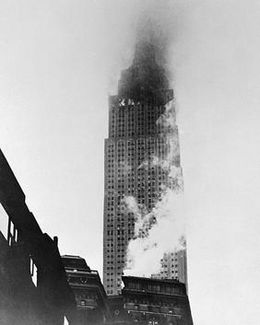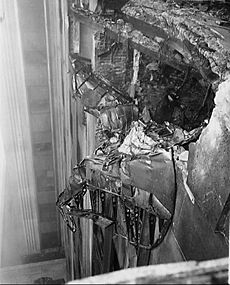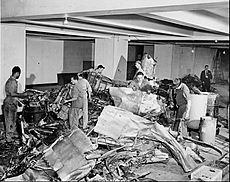1945 Empire State Building B-25 crash facts for kids

The Empire State Building on fire following the crash
|
|
| Accident summary | |
|---|---|
| Date | July 28, 1945 (79 years ago) |
| Summary | Controlled flight into terrain (building) in inclement weather conditions (fog). |
| Place | Empire State Building, New York City |
| Fatalities | 3 |
| Survivors | 0 |
| Aircraft type | B-25 Mitchell |
| Aircraft name | Old John Feather Merchant |
| Airline/user | United States Army Air Forces |
| Registration | 41-30577 |
| Flew from | Bedford Army Air Field Bedford, Massachusetts |
| Flying to | Newark Metropolitan Airport |
On July 28, 1945, a B-25 Mitchell bomber of the United States Army Air Forces crashed into the north side of the Empire State Building in New York City, while flying in thick fog. The accident killed fourteen people (three crewmen and eleven people in the building), and an estimated twenty-four others were injured. Damage caused by the crash estimated at US$1 million (equivalent to about $16 million in 2022), although the building's structural integrity was not compromised.
Incident
On Saturday, July 28, 1945, Lieutenant Colonel William Franklin Smith Jr., of Watertown, Massachusetts, was piloting a B-25 Mitchell bomber on a routine personnel transport mission from Bedford Army Air Field in Massachusetts to Newark Metropolitan Airport in New Jersey. Smith asked for clearance to land, but he was advised of zero visibility. Proceeding anyway, he became disoriented by the fog and turned right instead of left after passing the Chrysler Building.
At 9:40 a.m., the aircraft crashed into the north side of the Empire State Building, between the 78th and 80th floors, making an 18-by-20-foot (5.5 m × 6.1 m) hole in the building into the offices of the War Relief Services and the National Catholic Welfare Council. One engine shot through the south side opposite the impact, flew as far as the next block, dropped 900 feet (270 m), landed on the roof of a nearby building and caused a fire that destroyed a penthouse art studio. The other engine and part of the landing gear fell down an elevator shaft. The resulting fire was extinguished in 40 minutes. The Empire State Building fire is the highest structural fire to be brought under control by firefighters.
Between 50 and 60 sightseers were on the 86th floor observation deck when the crash happened. Fourteen people were killed: Colonel Smith, Staff Sergeant Christopher Domitrovich, and Navy Aviation Machinist's Mate Albert Perna, who was hitching a ride, and eleven civilians in the building. Approximately twenty to twenty-four others were injured as a result of the crash.
Aftermath
Despite the damage and deaths, the building was open for business on many floors on the next Monday morning, less than 48 hours later. The crash spurred the passage of the long-pending Federal Tort Claims Act, which was signed into law by President Harry S. Truman in August 1946, initiating retroactive provisions into the law and allowing people to sue the government for the accident.
After the debris had been cleared away, Armand Hammer purchased the damaged 78th floor, refurbished it, and made it the headquarters of his United Distillers of America.
On July 24, 1946, four days before the first anniversary of the crash, another aircraft narrowly missed striking the building. The unidentified twin-engine plane, described as bearing no military insignia, flew past the 68th floor and scraped the observation deck, startling workers and tourists there.
The events of the crash were the subject of an episode of the 2001 History channel documentary Disasters of the Century, "It Came from the Sky".
See also
- 1946 40 Wall Street Plane crash
- El Al Flight 1862
- September 11 attacks
- 2002 Tampa airplane crash
- 2002 Pirelli Tower airplane crash
- 2005 Iranian Air Force C-130 crash
- 2006 New York City plane crash
- 2014 Wichita King Air crash
- Skyscraper fire



